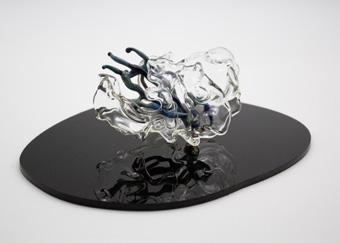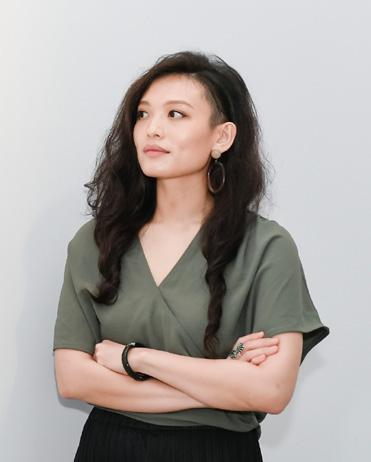
3 minute read
S T R A N G E S T R A N G E R S
by Para Site
In ecology, entities exist in mutual dependence and are composites of each other: They share similar DNA, cell structures, and molecules, and remain vital through constant exchanges of materials, wastes, and energies. In this vein, binaries and hierarchies of beings fissure and turn ambiguous; this engenders an uncanny feeling where one finds non-human life forms as strange strangers—familiarly strange, yet so strangely familiar.
In this duo presentation titled ‘Strange Strangers’, New York-based Chinese artist Shuyi Cao and Hong Kong artist Leelee Chan interlace, resonate, and juxtapose their sculptural approaches with one another. Tracing the flows and formative processes of matter, they aestheticise the queerness in ecology to envision how one may relate to the collective of beings in a planetary approach. Cao’s works probe the attributes of glazed stoneware, handblown borosilicate glass, and aqua resin, to unravel monstrous intimacy and queer kinship across myriad networked life forms and incompatible scales, summoning ontologies that wander between substances, residues, and impurities. Meanwhile, Chan's enigmatic works incorporate and transform urban debris, ancient artefacts, natural materials, and industrial products to evoke the shifting urban fabric of Hong Kong and accentuate the metamorphic nature of materials, opening up experimental possibilities to discover subversive logic and patterns beyond an anthropocentric worldview.
Cao's three handblown borosilicate glass works in the series Intimacy of Strangers (2023) integrate natural and synthetic material with idiosyncratic forms to highlight the central role of symbiosis in the evolution of early life. Elsewhere, her wall sculpture entitled pabulite (primordial bliss) (2023) visualises the dissection and deconstruction of biological specimens, presenting a mini-ecology that illustrates the violent yet intimate interspecies interactions through digestion and excretion. The multi-layered and lively glazed stoneware sculptures titled as they folded in and breached out (2022–23) invite the viewer to further ponder the symbiotic, mutualistic, parasitic, and cancerous relationships between elusive organisms, particularly how they undergo unexpected developments under extreme climate conditions. The four aqua resin wall pieces in vibrant violet hues titled Said N'ba N'ga (2021) speculate the evolving transmutation between aquatic and terrestrial life forms and encourage the audience to trace the complex formation and expansion of their lineage and kinship.

In Seaglass Equilibrium (2019), Chan probes the permeable circulation of urban debris and artificial products and highlights the barnacles' vital position in aquatic ecosystems, questioning the anthropocentric understanding of how non-human life forms solely serve instrumental value for mankind.

Ooliths (Yellow zinc) (2022) is a site-specific intervention that reflects upon the attachment nature of barnacles and how they form various networks and systems by absorbing and tracing energy flows. Circuit (New Moon) (2021) serves as an extended metaphor for the e ects moon phases have on marine life, and appears to be activating an alternative trajectory for evolution. Lithic Current (2023) surveys the form and significance of scholar's rocks to undermine distinctions between the natural and the non-natural by inviting the audience to witness the gathering of materials in movement and its ongoing formation. Moth (2023) morphs the artist's signature found plastic pallets with petrified wood into an ambiguous hybrid. Inspired by the behavioural patterns, symbolisms, and biological classification of moths, the work attempts to traverse the ideological fixation on nature and leap into the fissures of signification and subjectivity.
The visual identity designed by Fibi Kung echoes and expands on the artists’ visions and concepts. Consisting of three-dimensional renderings that fuse and mutate the artists' sculptural motifs as well as the scattered or clustered jet-black dots that resemble equivocal life forms, they respectively emulate the textural and material use of the sculptures and symbolise manifold modes of ecological thinking. In addition, there is also an olfactory experience with three scents provided by Aēsop over the course of the six-week exhibition period; the change of scent every fortnight activates three distinct viewing experiences vis-avis how one relates and interacts with other life forms and the environment. Holistically, ‘Strange Strangers’ aims to place the audience themselves in an otherworldly cosmos that arises in dependence upon the ‘mesh’ of queer ecology, with neither stricture, centre, nor even definition in sight.
SHUYI CAO

Born 1990 in Guangzhou; lives and works in New York
Shuyi Cao’s practice explores alchemical approaches to object making and the osmosis of knowledge. Through archeological speculation and ecological fiction, she contemplates the plurality of relations between technoscience, mythology, and cosmology. Her multimedia installations synthesise various materials and natural and artificial processes. Combining hand-crafted and digital artefacts, moving images, and sounds, the assemblages suggest heterogeneous material temporalities. She has exhibited internationally including at the NARS Art Foundation, New York (2021); Power Station of Art, Shanghai (2021); and MASS MoCA, North Adams, MA (2018). She is the recipient of the Today Art Museum Wang Shikuo
Nomination Award, The New School Tishman Environment and Design Center Research Grant, and MASS MoCA’s Assets for Artists Grant. She is an assistant professor at Pratt Institute and adjunct faculty at Parsons School of Design. She received her MFA from Parsons School of Design, New York, and her MPA ANd LLB from Fudan University, Shanghai.


